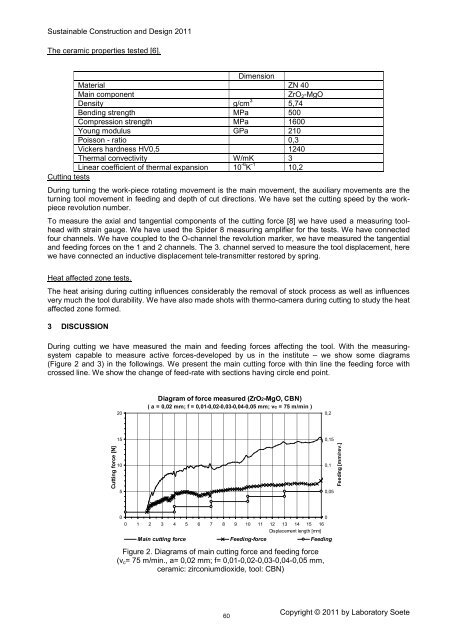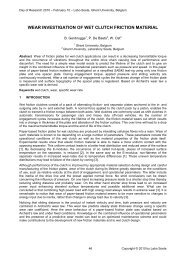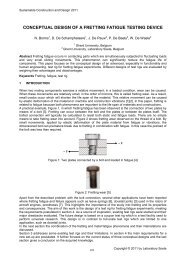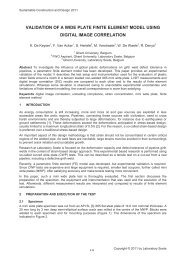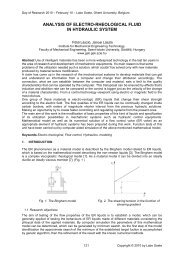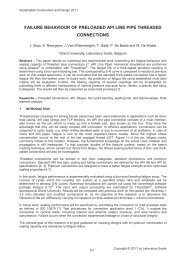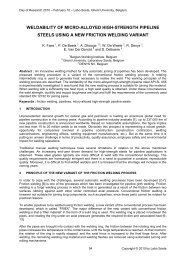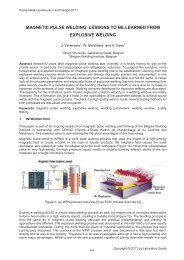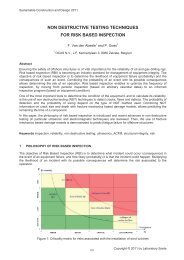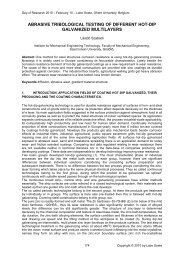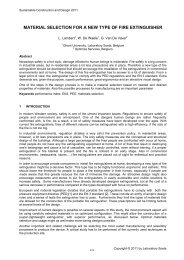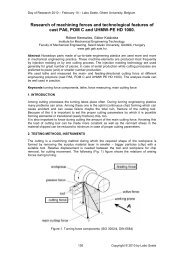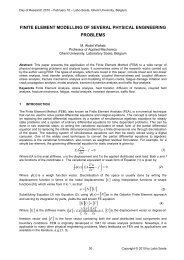Volume 2, Issue 1, 2011, Full Text - 5th International Conference on ...
Volume 2, Issue 1, 2011, Full Text - 5th International Conference on ...
Volume 2, Issue 1, 2011, Full Text - 5th International Conference on ...
Create successful ePaper yourself
Turn your PDF publications into a flip-book with our unique Google optimized e-Paper software.
Sustainable C<strong>on</strong>structi<strong>on</strong> and Design <str<strong>on</strong>g>2011</str<strong>on</strong>g><br />
The ceramic properties tested [6].<br />
Dimensi<strong>on</strong><br />
Material ZN 40<br />
Main comp<strong>on</strong>ent<br />
ZrO 2 -MgO<br />
Density g/cm 3 5,74<br />
Bending strength MPa 500<br />
Compressi<strong>on</strong> strength MPa 1600<br />
Young modulus GPa 210<br />
Poiss<strong>on</strong> - ratio 0,3<br />
Vickers hardness HV0,5 1240<br />
Thermal c<strong>on</strong>vectivity W/mK 3<br />
Linear coefficient of thermal expansi<strong>on</strong> 10 -6 K -1 10,2<br />
Cutting tests<br />
During turning the work-piece rotating movement is the main movement, the auxiliary movements are the<br />
turning tool movement in feeding and depth of cut directi<strong>on</strong>s. We have set the cutting speed by the workpiece<br />
revoluti<strong>on</strong> number.<br />
To measure the axial and tangential comp<strong>on</strong>ents of the cutting force [8] we have used a measuring toolhead<br />
with strain gauge. We have used the Spider 8 measuring amplifier for the tests. We have c<strong>on</strong>nected<br />
four channels. We have coupled to the O-channel the revoluti<strong>on</strong> marker, we have measured the tangential<br />
and feeding forces <strong>on</strong> the 1 and 2 channels. The 3. channel served to measure the tool displacement, here<br />
we have c<strong>on</strong>nected an inductive displacement tele-transmitter restored by spring.<br />
Heat affected z<strong>on</strong>e tests.<br />
The heat arising during cutting influences c<strong>on</strong>siderably the removal of stock process as well as influences<br />
very much the tool durability. We have also made shots with thermo-camera during cutting to study the heat<br />
affected z<strong>on</strong>e formed.<br />
3 DISCUSSION<br />
During cutting we have measured the main and feeding forces affecting the tool. With the measuringsystem<br />
capable to measure active forces-developed by us in the institute – we show some diagrams<br />
(Figure 2 and 3) in the followings. We present the main cutting force with thin line the feeding force with<br />
crossed line. We show the change of feed-rate with secti<strong>on</strong>s having circle end point.<br />
20<br />
Diagram of force measured (ZrO2-MgO, CBN)<br />
( a = 0,02 mm; f = 0,01-0,02-0,03-0,04-0,05 mm; vc = 75 m/min )<br />
0,2<br />
Cutting force [N]<br />
15<br />
10<br />
5<br />
0,15<br />
0,1<br />
0,05<br />
Feeding [mm/rev.]<br />
0<br />
0<br />
0 1 2 3 4 5 6 7 8 9 10 11 12 13 14 15 16<br />
Displacement length [mm]<br />
Main cutting force Feeding-force Feeding<br />
Figure 2. Diagrams of main cutting force and feeding force<br />
(v c = 75 m/min., a= 0,02 mm; f= 0,01-0,02-0,03-0,04-0,05 mm,<br />
ceramic: zirc<strong>on</strong>iumdioxide, tool: CBN)<br />
60<br />
Copyright © <str<strong>on</strong>g>2011</str<strong>on</strong>g> by Laboratory Soete


